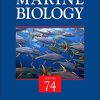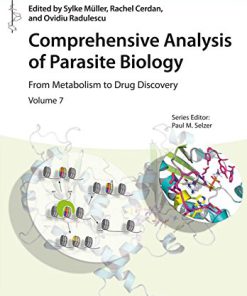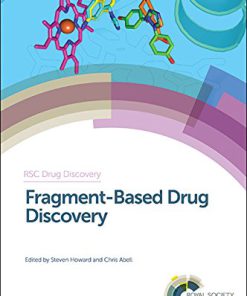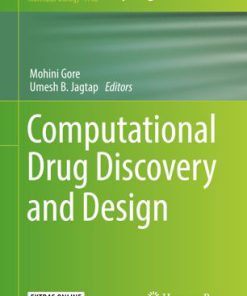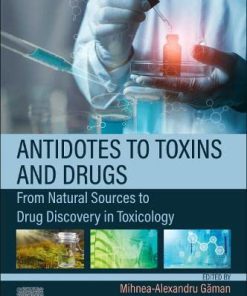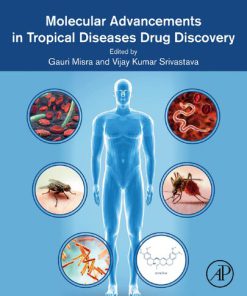Antibiotic Drug Discovery New Targets and Molecular Entities 1st Edition by Steven Firestine, Troy Lister ISBN 9781788011495 178801149X
$50.00 Original price was: $50.00.$25.00Current price is: $25.00.
Antibiotic Drug Discovery New Targets and Molecular Entities 1st Edition by Steven Firestine, Troy Lister – Ebook PDF Instant Download/Delivery: 9781788011495 ,178801149X
Full download Antibiotic Drug Discovery New Targets and Molecular Entities 1st Edition after payment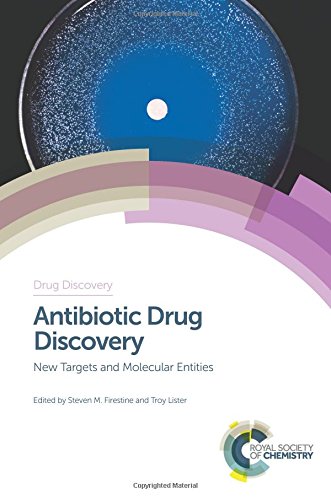
Product details:
ISBN 10: 178801149X
ISBN 13: 9781788011495
Author: Steven Firestine, Troy Lister
Recent years have seen a resurgence of antibiotic drug discovery. This book brings together the relevant information to assess the state-of-the-art. It identifies and elaborates the most recent and compelling strategies for antibiotic drug discovery with a primary focus on new targets, mechanisms and molecular entities. Addressing the need for continued investment in antibiotic drug development, the book provides a point of reference for the rapidly expanding infectious disease research community.
In addition to its attention on new targets, the book focusses on the medicinal chemistry and chemistry of the targets. Within this framework, chapters from leading researchers in academia and industry address findings in important areas such as biofilm production, narrow spectrum antibiotics and novel antibacterials from previously uncultured soil bacteria.
This book will be a useful resource for postgraduate students and researchers in medicinal chemistry wishing to understand the latest approaches to antibiotic drug discovery.
Antibiotic Drug Discovery New Targets and Molecular Entities 1st Edition Table of contents:
Chapter 1 Treatment of Clostridium difficile Infections
1.1 Background
1.2 CDI Symptoms and Progression
1.3 Relapse
1.4 Diagnosis
1.5 Prevention Measures—General Hospital Practice and Other Prevention Methods
1.6 Current Treatment and Antibiotics
1.6.1 Anti-Toxins
1.6.2 Vaccines
1.6.3 Anti-Germinants
1.6.4 Fecal Transplantation
1.6.5 Probiotics
1.7 Conclusion
References
Chapter 2 Targeting Purine Biosynthesis for Antibacterial Drug Design
2.1 Introduction
2.1.1 The De novo Purine Nucleotide Biosynthesis Pathway
2.1.2 The Purine Conversion Pathways
2.1.3 The Purine Salvage Pathways
2.1.4 Availability of Purine Bases and Nucleosides
2.1.5 The Complex Interplay Between Salvage Pathways and Precursor Availability
2.2 The Essentiality of Enzymes of the Purine Biosynthetic Pathways
2.2.1 Essentiality of Purine Nucleotide Biosynthesis for Growth in Rich Media
2.2.2 Essentiality of Purine Nucleotide Biosynthesis During Infection
2.2.3 Inhibitors May Not Have the Same Phenotypes as Gene Knockouts
2.2.4 The Problem of Resistance
2.3 Progress Targeting the Enzymes of De novo Purine Nucleotide Biosynthesis
2.4 Progress Targeting Enzymes in the Purine Nucleotide Conversion Pathways
2.4.1 IMPDH Structure and Mechanism
2.4.2 Prokaryotic and Eukaryotic IMPDHs: A Comparative Analysis of Rational Drug Design
2.4.3 Repurposing Cryptosporidium IMPDH Inhibitors as Antibiotics
2.5 Conclusion
References
Chapter 3 Inhibitors of Biofilm Production
3.1 Introduction
3.2 Biofilms
3.3 Strategies for Combating Biofilms
3.3.1 Quorum Sensing Inhibitors
3.3.2 Inhibitors of AHL Based Quorum Sensing as Biofilm Inhibitors
3.3.3 Inhibitors of AIP-Based Quorum Sensing as Biofilm Inhibitors
3.3.4 Inhibitors of AI-2 Based Quorum Sensing as Biofilm Inhibitors
3.4 Inhibition of Bacterial Signaling Pathways
3.4.1 Interference with c-di-GMP Signaling to Inhibit Biofilm Formation
3.4.2 Inhibition of Indole Signaling Pathways to Prevent Biofilm Formation
3.4.3 Inhibition of Two-Component Signal Transduction Systems (TCS) to Prevent Biofilm Formation
3.4.4 Inhibition of Other Signaling Pathways to Prevent Biofilm Formation
3.5 Identification of Natural Products and Analogues that Prevent Biofilm Formation
3.5.1 Plant Natural Products and Analogues that Prevent Biofilm Formation
3.5.2 Marine Natural Products and Analogues that Prevent Biofilm Formation
3.5.3 Other Natural Products that Prevent Biofilm Formation
3.6 Antimicrobial Peptides (AMPs) that Prevent Biofilm Formation
3.7 Inhibition of Efflux to Prevent Biofilm Formation
3.8 Matrix Degradation to Prevent Biofilm Formation
3.9 Conclusions
References
Chapter 4 Narrow Spectrum Antibacterial Agents
4.1 Introduction
4.2 Natural Products
4.3 Synthetic and Target-Based Approaches
4.4 Future Prospects
4.5 Conclusions
References
Chapter 5 The LPS Transport Pathway: A New Target for the Development of Gram-Negative Antibiotics
5.1 Introduction
5.2 Lipopolysaccharide (LPS) and the Gram-Negative Cell Envelope
5.3 The LPS Biosynthesis Pathway
5.3.1 Kdo2-Lipid A
5.3.2 Core Polysaccharide
5.3.3 O-Antigen
5.4 LPS Modification and Its Role in Gram-Negative Bacterial Persistence
5.5 LPS Transport: The Lpt Pathway
5.5.1 Extraction of LPS from the IM
5.5.2 Traversing the Periplasm: The LptA Protein Bridge
5.5.3 LPS Insertion into the OM
5.6 LPS Transport as a New Target for the Development of Gram-Negative Antibiotics
5.7 Conclusions
References
Chapter 6 The Discovery of Teixobactin
6.1 Introduction
6.2 Cultivating the Unculturable – The iChip
6.3 Teixobactin – A Novel Antibiotic
6.4 Structural Determination of Teixobactin
6.5 Synthesis of Teixobactin and Analogues
6.6 Conclusion
References
Chapter 7 Emerging Targets in Anti-Tubercular Drug Design
7.1 Introduction
7.1.1 The Biology and Pathology of TB
7.1.2 Current Drug Targets
7.1.3 Resistance Related to TB
7.2 Discovery and Validation of Novel Drug Targets in TB
7.2.1 Targets Involved in Mycobacterium tuberculosis Cell Envelope Biosynthesis
7.2.2 Targets Involved in Mycobacterium tuberculosis General Metabolism
7.3 Synergistic Drug Combination Therapy
7.3.1 Unrelated Compounds
7.3.2 Inhibitors of Resistance Enzymes
7.3.3 P2X7 Receptor Agonist
7.4 Conclusion and Perspectives
References
Chapter 8 Antibacterial Leads Targeting Isoprenoid Biosynthesis
8.1 Introduction
8.2 Targeting the MVA Pathway
8.2.1 Historic Compounds Inhibiting the MVA Pathway
8.2.2 Screening for Inhibitors of the MVA Pathway in Bacteria
8.2.3 Targeting the GHMP Kinase Family Members of the MVA Pathway
8.3 Targeting the MEP Pathway
8.3.1 Historic Compounds Inhibiting the MEP Pathway
8.3.2 Inhibiting DXS
8.3.3 Inhibiting IspC
8.3.4 Inhibiting IspD
8.3.5 Inhibiting IspE
8.3.6 Inhibiting IspF
8.3.7 Inhibiting IspG and IspH
8.4 Alternate Targets Utilizing IPP Precursors
8.4.1 Inhibiting IDI
8.4.2 Inhibiting UppS
8.4.3 Inhibiting Staphyloxanthin Biosynthesis
8.5 Conclusions
References
Subject Index
People also search for Antibiotic Drug Discovery New Targets and Molecular Entities 1st Edition:
antibiotic drug development
new drug discovery targets
antibiotic that targets nucleic acid synthesis
new antibiotic discovered
Tags:
Steven Firestine,Troy Lister,Antibiotic Drug,Discovery,Targets,Molecular Entities
You may also like…
Chemistry - Chemistry - General & Miscellaneous
Chemistry - Chemistry - General & Miscellaneous
Molecular Evolutionary Models in Drug Discovery 1st Edition by Juan Bueno 0128189290 9780128189290
Science (General)
Business & Economics
Drug Discovery Targeting Drug-Resistant Bacteria 1st Edition Prashant 0128184817 9780128184813
Medicine - Infectious diseases
Science (General)


